In the last issue, we discussed the political situation in the early 4th century AD — the reigns of Diocletian and Constantine. In this period of political stability, Rome had its last burst of building projects. In projects like the Baths of Diocletian, Roman builders used concrete and brick to create “soaring heights”; they were willing to sacrifice “external beauty” in order to create striking internal spaces.

The Baths of Diocletian. Note the arched windows, divided into three parts.
Such windows are known as “Diocletian windows.”
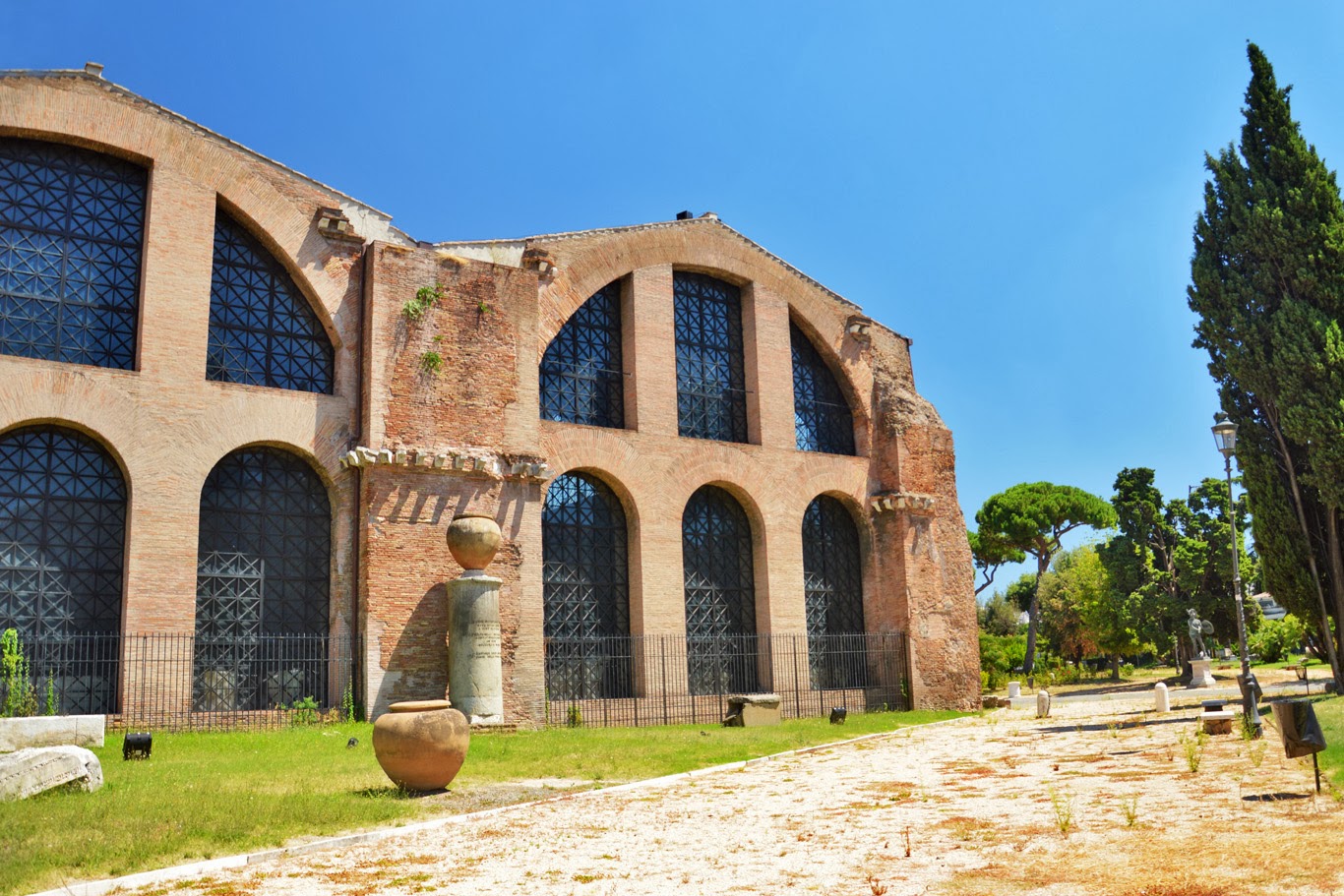
Another view of the Baths of Diocletian, showing the “Diocletian windows.”
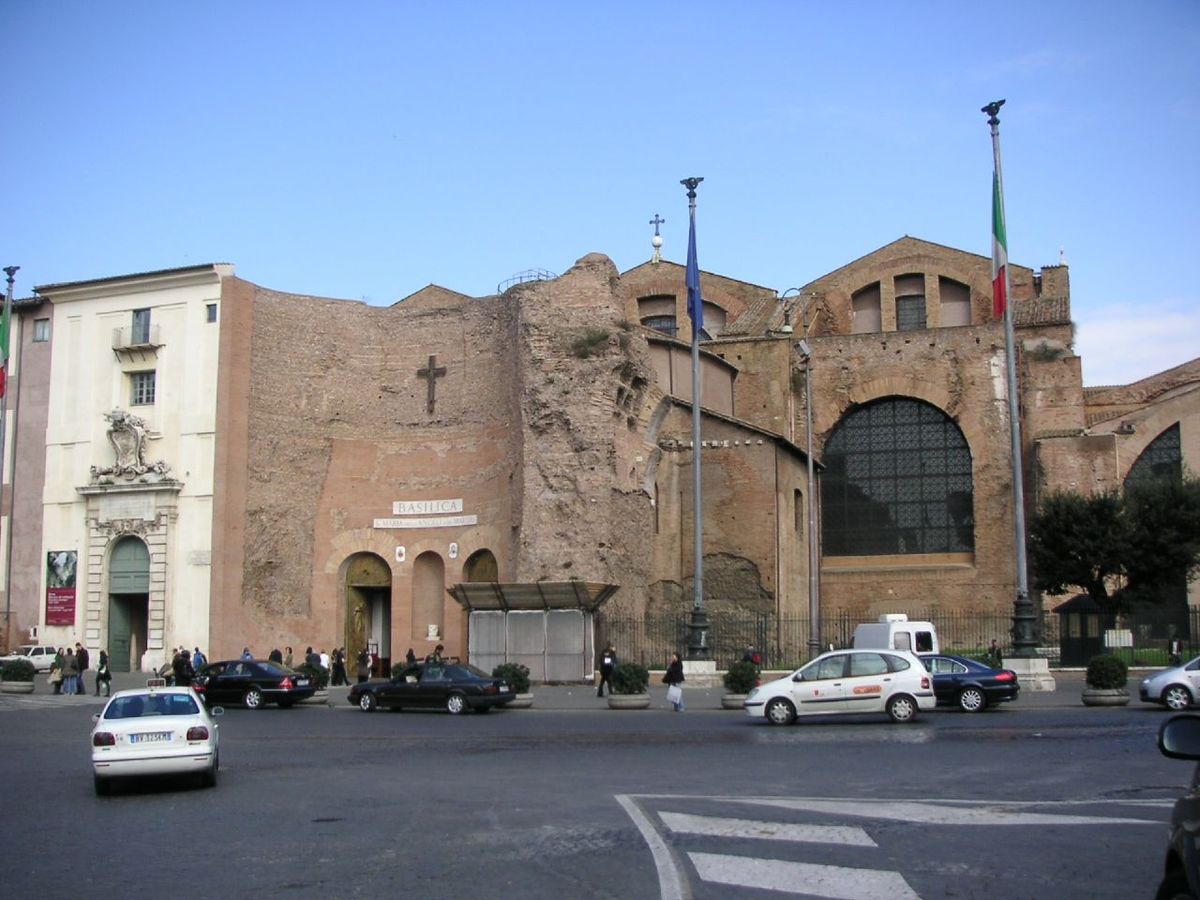
In the 1500s, Michelangelo converted part of the Baths of Diocletian
into The Basilica of St. Mary of the Angels and the Martyrs
(Santa Maria degli Angeli e dei Martiri).
This photo shows the entrance of the church.
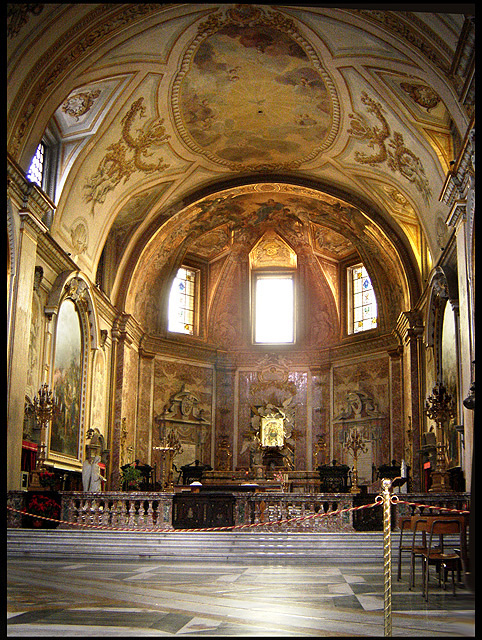
Interior of The Basilica of St. Mary of the Angels and the Martyrs
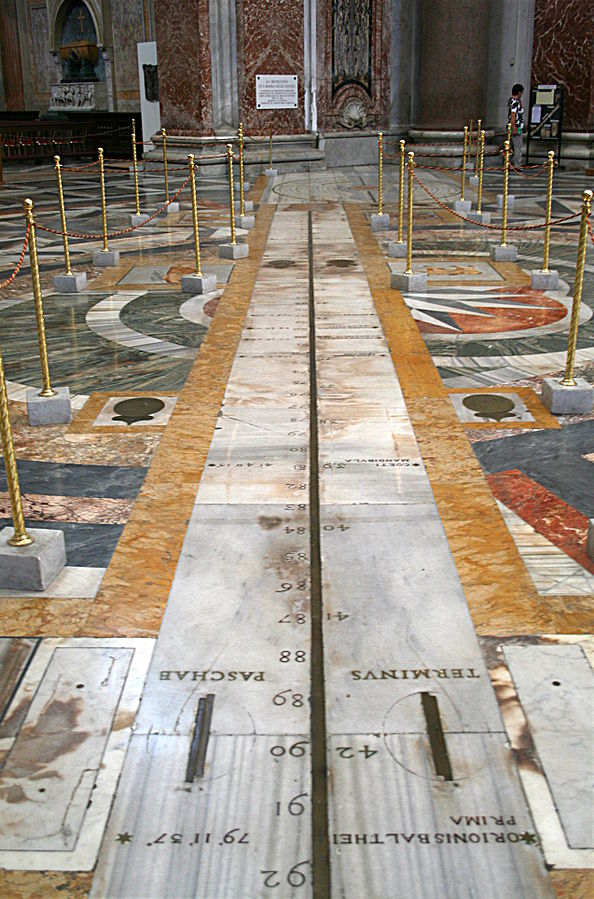
|
| Meridian line on the floor of The Basilica of St. Mary of the Angels and the Martyrs. “At the beginning of the eighteenth century, Pope Clement XI commissioned the astronomer, mathematician, archaeologist, historian and philosopher Francesco Bianchini to build a meridian line, a sort of sundial, within the basilica.... The sun shines through a small hole in the wall to cast its light on this line each day. At the summer solstice, the sun appears highest, and its ray hits the meridian line at the point closest to the wall. At the winter solstice, the ray crosses the line at the point furthest from the wall. At either equinox, the sun touches the line between these two extremes.... The ancient walls had long since stopped settling into the ground, ensuring that [the hole] would not move out of place.” |
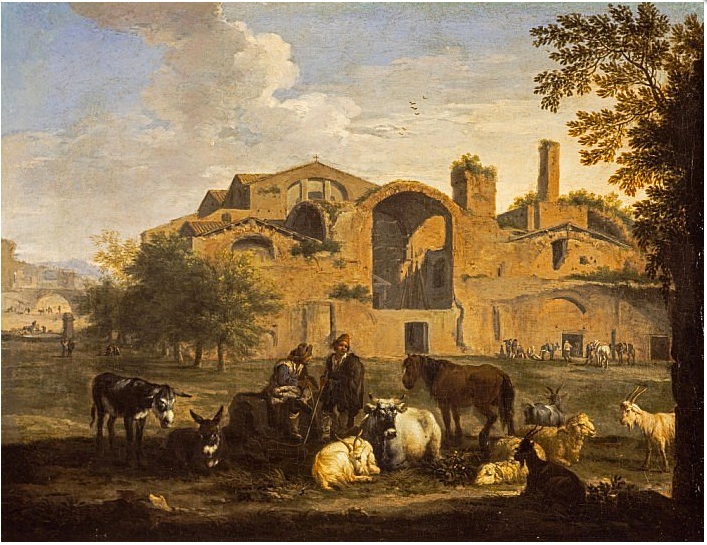
The Baths of Diocletian in a painting by Flemish artist Pieter van Bloemen1
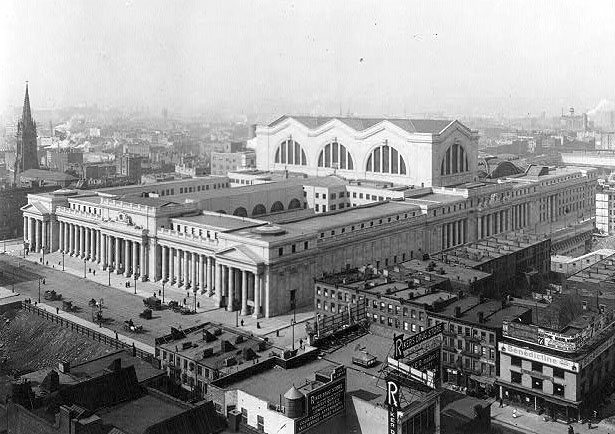
The old Penn Station in New York City, demolished in the 1960s.
Note the Diocletian windows (5-pane instead of 3-pane).
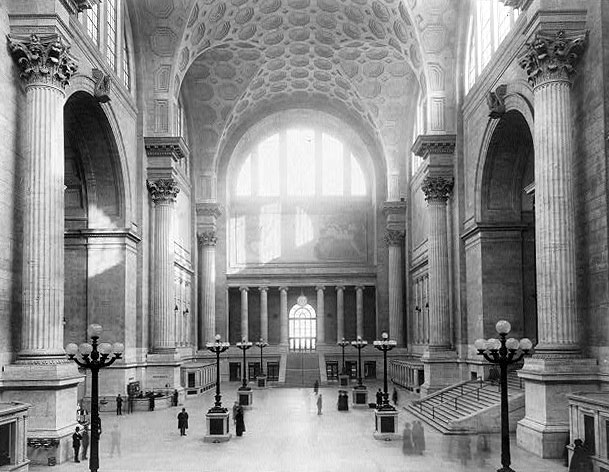
Old Penn Station, showing Diocletian window from the inside
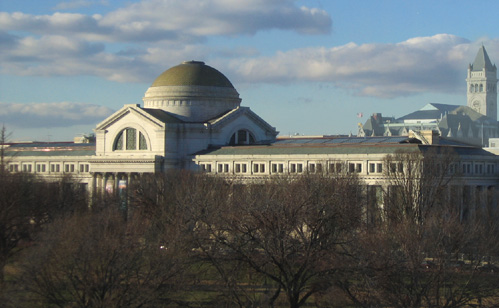
3-pane Diocletian window at the Smithsonian Museum of Natural History
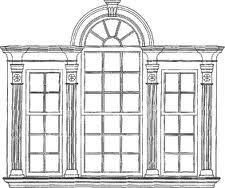
Palladian window, a derivative of the Diocletian window
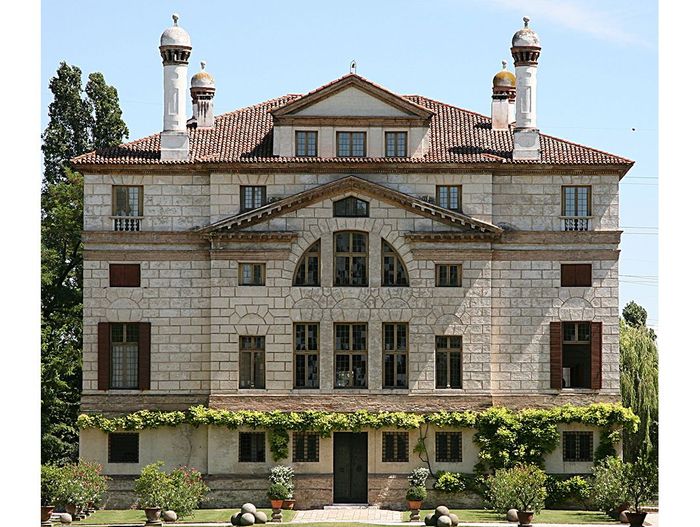
Diocletian window in the Villa Foscari in Mira, near Venice.
The Villa Foscari was designed by Palladio around 1560.
(Oxfordians believe that the Villa Foscari is the model
for Belmont, Portia’s estate in The Merchant of Venice.)
Constantine and his father often resided at Trier (formerly known in English as Treves), in what is now western Germany. They carried out several building projects in Trier, including a city gate (the Porta Nigra), a basilica (now a church), and a bath complex. Trier now has “the most remarkable group of surviving Roman edifices in western Europe.”2
In Sicily, the Villa Romana del Casale was built in the early 300s, perhaps by Maximian. It has the best collection of Roman mosaics, and is a UNESCO World Heritage Site.

Mosaic from the Villa Romana del Casale, near the town of Piazza Armerina
At Thessaloniki in Greece, a mausoleum was built by Galerius (one of Diocletian’s tetrarchs). It was soon turned into a church, and called The Rotunda; it’s now one of the oldest Christian churches.
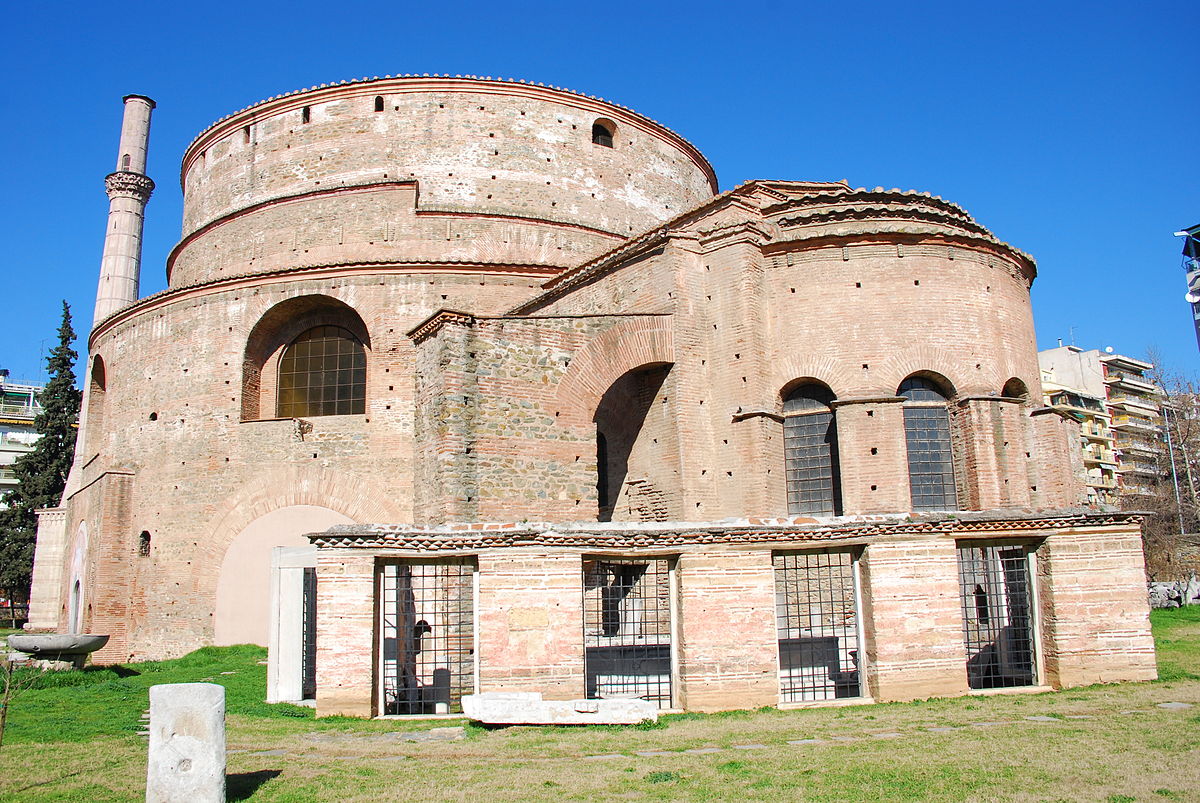
The Church of the Rotunda at Thessaloniki
Another old church was St. Peter’s Basilica at Rome, built under Constantine on the reputed site of St. Peter’s grave. Constantine’s St. Peter’s was replaced by the current St. Peter’s around 1500.
In visual art, Christian images gradually replaced pagan images. Christ was often depicted as The Good Shepherd (a shepherd carrying one of his sheep).
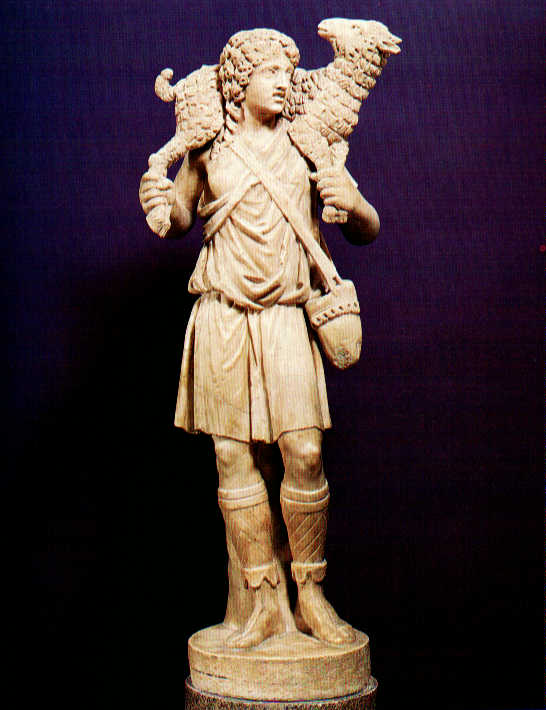
Our authors praise the historian Dio Cassius (also known as Cassius Dio, or simply Dio).3 Dio wrote in Greek, and dealt with the history of Rome from its origin to 229 AD (Dio himself died in 235 AD). About half of Dio’s work survives — the chapters that deal with the late Republic and the early Empire. Dio “provided a link between the long chain of classical Greek historians and the numerous and competent historical authors of the Byzantine age [such as Procopius].”4
Another Greek historian, Herodian, lived at about the same time as Dio. His work, like Gibbon’s, begins with the accession of Commodus in 180 AD, and it ends in 238 AD. Our authors say that Herodian’s work is “rhetorical and superficial, but certainly not without considerable value.”
During this period, Christian literature was beginning to outshine pagan literature. One of the major Christian writers of this period was Eusebius, who wrote a biography of Constantine, a history of the Church, and other works. In his Ecclesiastical History, Eusebius describes the Church’s struggles against persecution from without, and heresy from within. Eusebius wrote in Greek. Christian writers also took up the cudgels against peasant religions, rural cults.
Turning to philosophy, our authors praise the work of Plotinus, who lived during the Crisis of the Third Century. Plotinus was born in Egypt, studied in Alexandria, and taught in Rome. His best student was Porphyry, who tried to popularize Plotinus’ philosophy, and also became a well-known author in his own right.
In an earlier issue, I wrote that the mystic/magician Apollonius of Tyana is said to have “travelled to India in search of Eastern wisdom.” Likewise, after Plotinus had studied in Alexandria for about ten years, Plotinus decided
| to investigate the teachings of the Persian philosophers and the Indian philosophers. [He] left Alexandria and joined the army of Gordian III as it marched on Persia. However, the campaign was a failure, and on Gordian’s eventual death Plotinus found himself abandoned in a hostile land, and only with difficulty found his way back to safety in Antioch. |
Plotinus is considered a Neoplatonist, emphasizing spirit over matter, and his work was “the most methodical attempt to explain the universe since the days of Plato and Aristotle.”
Alexandria was probably the birthplace of Hermetic literature, which was written in Greek, preserved in the libraries of Constantinople, and finally made its way to Italy around 1450.
As for literature written in Latin, the 4th century AD was a sterile period, both in prose and poetry. But our authors have high praise for one 4th-century Latin historian, Ammianus Marcellinus, saying that he “stood not far behind Tacitus in the accuracy of his record and in his grasp of political situations and characters.”5 Ammianus’ history covered about 300 years, but only the last 25 years have survived.
Our authors are scornful of the Historia Augusta, a series of biographies of emperors, covering the period 117 AD to 284 AD; our authors speak of “the unblushing manner in which they forged documentary evidence.” There have been many scholarly debates about the Historia Augusta — when was it written, who wrote it, etc.
Older books, like the voluminous works of Livy, were no longer read, or read only in abridged form. Much of this earlier literature was lost “for lack of readers.” More literature would have been lost if books had continued to be made from papyrus, but during the 4th century AD, books began to be made from parchment (animal skin), which is more durable than papyrus.
In an earlier issue, I mentioned that Diocletian called himself “Jovius,” and gave his colleague (Maximian) the name “Herculius.” Diocletian took a conservative approach to religion, supporting the old polytheism, and respecting oracles. He banned Manichaeism, a new religion from Persia, developed by a prophet named Mani.
Diocletian also persecuted Christians more harshly and persistently than they had ever been persecuted before. This persecution didn’t begin until 303 AD, near the end of Diocletian’s reign.6 It began with the destruction of churches and the burning of scriptures. Then it intensified, perhaps because of mysterious fires in the emperor’s palace, fires that were blamed on Christians. The persecution was largely confined to the eastern provinces, where Diocletian and Galerius held sway; in the western provinces, Christians were unmolested.7 The persecution continued after Diocletian retired in 305, and finally ended in 311, when Galerius died.
When Constantine came to power, all religions were tolerated, but Christianity was favored. Constantine made Sunday a day of rest, and he prohibited the construction of pagan temples in Constantinople. Though many years would pass before Christians made up a majority in the Empire, it was clear that Christianity was growing as no other religion in the Empire was. During the reign of Theodosius (378-395 AD), the government not only embraced Christianity as the official religion, it also “launched a bitter campaign to suppress paganism.”8
As Christianity grew, it became a secular force as well as a spiritual force. Bishops became as powerful as imperial officials. The church performed government functions such as helping the poor, and building hospitals and orphanages. Constantine decreed that the church could accept gifts and bequests, so the church acquired the financial means to perform social services.
While all bishops were powerful, the bishop of Rome was especially powerful. This was partly because the church patterned its structure on the structure of the Roman Empire, and in the Roman Empire, Rome was the center of power. Furthermore, Roman bishops argued that Peter had founded the Roman church, and Jesus had said that his church was founded on Peter (“upon this rock I will build my church”). As successors of Peter, the Roman bishops felt that they should be the supreme head of the Christian church. The other bishops agreed to this, and in 381 AD, the Council of Constantinople decreed that the bishop of Rome was the head of the church (pope). He continued to be the head of the church until the Great Schism of 1054, when the Eastern church became independent.
The early popes took an active role in civic affairs as well as religious affairs; when the Western Empire collapsed, popes became even more important in politics.
Some Christians believed that “the world is too much with us,” and they fled from the turmoil of politics and war. They tried to focus on the spiritual life. They became monks (from the Greek monos, meaning “alone”). Early monks lived as hermits (“hermit” comes from eremita, “desert-dweller”). These early monks lived in Egypt and the eastern provinces.
But soon a new form of monasticism developed, the monastic community. These communal monks were called “cenobites” (as opposed to hermits or anchorites). While the hermits had lived solitary, ascetic lives, the cenobites engaged in various forms of labor. Around 360 AD, rules for monastic life were drawn up by St. Basil; Basil’s rules are still used by the Eastern church.
Monasticism eventually reached the western provinces, where St. Benedict played an important role in its development. Around 500 AD, Benedict drew up rules for monastic life, and founded the monastery at Monte Cassino. Many monasteries had libraries, and monks played a key role in copying and preserving literature.
In 378 AD, the Goths inflicted a crushing defeat on the Romans at the Battle of Adrianople. (Adrianople is about 75 miles northwest of Constantinople; it’s named after Hadrian, as Constantinople is named after Constantine; Adrianople is known today as “Edirne.”) The Battle of Adrianople is important because it showed that the barbarians could defeat the Romans in a set battle, and could settle down inside the Empire; after this battle, the barbarians never left the Empire. The Battle of Adrianople was described by the historian Ammianus Marcellinus, who compared it to the Battle of Cannae (216 BC), in which Hannibal defeated the Romans.
The last emperor to rule over a united empire was Theodosius (also known as Theodosius I, or Theodosius the Great), who died in 395 AD. Theodosius has been called “Rome’s last great emperor.”9 After the death of Theodosius, the empire was divided between his sons — Arcadius ruled in the East, Honorius in the West.
The Western Empire was invaded by German tribes. The Franks conquered northern Gaul around 410 AD. The Burgundians conquered east-central Gaul, the Suebi and Vandals conquered Spain. In 410 AD, the Visigoths under King Alaric sacked Rome. Around 430 AD, the Vandals crossed from Spain into North Africa, established pirate bases, and disrupted shipping in the Mediterranean.
One cause of these invasions was that an Asian people, the Huns, were pushing westward, forcing the Goths and Germans into Roman territory. In 451 AD, a Roman general named Aetius, with help from the Visigoths, defeated Attila and his Huns, who had invaded France.10 This was a time of turmoil, in which barbarians fought Romans, barbarians fought other barbarians, Roman emperors partnered with barbarians to defend themselves against other barbarians, etc. In 476 AD, the Western Empire officially ended when a German chief named Odoacer killed the general Orestes, and deposed his son, emperor Romulus Augustulus.
Even as the barbarians were crashing into the Western Empire, they respected Roman civilization. Alaric, for example, who sacked Rome in 410 AD, idealized Rome’s Golden Age, and had his followers call him by the Romanized name “Alaricus.” Alaric and other barbarian chiefs were eager to receive high positions in the Roman army, even as they were fighting the Romans. This respect for Rome inspired the barbarians to establish kingdoms in the West that were based, at least partly, on Roman customs, Roman laws, Roman language, etc. Thus, Europe’s medieval kingdoms became a fusion of Germanic, Roman, and Christian elements.
One of the Germanic elements in medieval society was the warrior’s loyalty to his lord:
| One of the most important elements in German society was the comitatus, a band of fighting companions bound by inviolate ties of personal loyalty to a chief who maintained them in return for their fighting services. From this institution, among others, medieval feudalism developed.11 |
When Rome was sacked in 410 AD, it seemed to many people that the world was coming to an end. In Bethlehem, St. Jerome wrote, “The lamp of the world is extinguished.” In North Africa, St. Augustine wrote The City of God, in which he argued that the Roman Empire’s embrace of Christianity didn’t cause its decline.
After the barbarians settled inside what had been the Roman Empire, and established their kingdoms, they gradually became soft and satisfied. After a few centuries, a new wave of barbarians descended from the North — the Vikings, or Norsemen — and attacked eastern England, northern France, etc. And the Arabs, newly converted to Islam, emerged from the Arabian Peninsula, and conquered North Africa, Spain, etc.
While the Western Empire was being overrun by barbarians, the Eastern Empire enjoyed a long period of stability following the death of Theodosius in 395 AD. The Eastern Empire became the Byzantine Empire; or perhaps I should say, we refer to the later Eastern Empire as the Byzantine Empire. The church/mosque known as Hagia Sophia (Holy Wisdom) was built around 530 AD, during the reign of Justinian. “Two of the greatest monuments of Roman statecraft, the code of Theodosius II on administrative law (438 AD) and the general code of Justinian (c. 530 AD), had their origin at Constantinople.”12 These law codes were written largely in Latin, which was the language of the courts, though not the language of the street. Only gradually did the Byzantine Empire adopt Greek as their official language.13 Our authors say that the Byzantine monarchy was more Greek than Roman; they describe it as “a Hellenistic kingdom, with a Christian Church and a Roman law-book.”
The Byzantines continued studying the Greek classics, and thus they preserved much Greek literature. When the Turks closed in on Constantinople around 1450, Byzantine scholars fled to Italy, bringing Greek texts with them.
Justinian tried to restore the Roman Empire; he managed to re-conquer Italy, North Africa, etc. But he was attacked by the Persians from the east, and by the barbarians from the north. “Justinian’s program of reconstituting the old Roman Empire resulted in no lasting gain in the West, jeopardized the heart of the Empire which was in the East, and imposed an almost intolerable burden on his hard-pressed subjects.”14 To make matters worse, Justinian’s empire suffered from a devastating plague. The Byzantine realm gradually contracted during the next three centuries.
Justinian aimed not only to restore the Roman Empire, but also to suppress heresy, convert pagans, and unite the Church. As part of his anti-pagan effort, Justinian closed two Athenian schools, Plato’s Academy and Aristotle’s Lyceum, where philosophy had been taught for almost 1,000 years. The suppression of heresy was an ongoing struggle, and was never completely successful. (The problem of heresies/sects within Christianity might be compared to the problem of heresies/sects within Islam; Islam has long been divided between Sunnis and Shiites, and there are smaller sects, too, like the Alawites.)
Byzantine control of Italy was short-lived. In 568 AD, a tribe called the Lombards invaded northern Italy, and occupied it for the next two centuries. In 800 AD, Charlemagne, the King of the Franks, controlled northern Italy and much of western Europe; he was crowned emperor by the Pope in St. Peter’s. Around 950, Charlemagne’s empire (the Carolingian Empire) was replaced by a Saxon empire. In 962 AD, the Saxon ruler Otto I established the Holy Roman Empire, and declared himself emperor. Thus, vestiges of the Roman Empire lingered on, even in western Europe.
Under Charlemagne, as under Otto and his successors, learning was respected, and Roman literature was copied and preserved.15 Under Charlemagne, an English scholar named Alcuin played a key role in literary projects. Alcuin helped to develop lowercase letters and punctuation.
Our authors discuss various theories that have been put forward to explain the decline of the Roman Empire (or rather, the decline of the western Empire; the eastern Empire lasted much longer). They dismiss theories about soil-depletion, weather, plague, etc. They do argue, however, that
| Warfare... by its very nature ensures the premature death of the fittest.... It is perhaps not a mere accident that after the first century AD, Italy, which had been remorselessly combed out for recruits by the Roman war-machine, supplied hardly any fighting men for the service of Rome, and produced scarcely a single important figure in the field of war or of letters.16 |
Our authors say that the “chief proximate cause of the Decline” was that Roman armies were tempted to oust the emperor and choose a new emperor; they call this “the game of emperor-making.” They say, “The Roman army both made and unmade the Roman Empire.” Our authors argue that this problem might have been solved by drafting a militia army, an army that would have been positioned between Rome and the professional armies on the frontiers.
Our authors reject Gibbon’s view that Christianity contributed to the fall of the Roman Empire. They do admit, however, that beginning around 300 AD, Christianity
| drew to itself away from the service of the state some of the best men who otherwise would have become generals, provincial governors or imperial courtiers. This process was accelerated by the growth of monasticism from the second part of the fourth century. |
Christianity helped to civilize the barbarians who conquered the Western Empire; even Gibbon admitted that Christianity had a “beneficial” effect on the barbarians.17 Christianity smoothed the transition from one civilization to the next — from Greco-Roman civilization to medieval civilization. Many barbarians, like Alaric, became Christians before they invaded the Empire; a missionary named Ulfilas had converted many Goths to Christianity around 340 AD. But Ulfilas belonged to the Arian sect, which was at odds with orthodox Christians, so the orthodox viewed the barbarians as heretics.
Christianity wasn’t the only civilizing force. The barbarians on Rome’s borders were also civilized by contact with Rome in general. They learned from the Roman army, Roman architecture, Roman books, etc., just as the Romans had once learned from the Greeks. In an earlier issue, I wrote
| As the poet Horace said, “Captured Greece took the savage victor captive [Graecia capta ferum victorem cepit].” One is reminded of China civilizing the conquering Mongols and Manchus. |
Now it was Rome’s turn to be the educator and civilizer — Roma capta ferum victorem cepit.
Does the fate of Roman civilization contain any clues about the fate of our own civilization? Parts of Roman civilization died, other parts were incorporated into medieval civilization, and still other parts moved eastward to the Byzantine Empire. Likewise, parts of our own civilization will doubtless die, other parts may be incorporated into a new civilization, and still other parts may find a home outside their current home.
There were probably signs of decline in Rome as early as 100 BC, but Rome lasted many more centuries. Likewise, our civilization doubtless shows signs of decline, but will probably last many more centuries. Politicians are fond of saying “it’s morning in America,” and “our best days are ahead of us,” but perhaps we should admit that it’s afternoon. Perhaps we should accept decline, and try to manage decline. If we don’t accept it, if we angrily resist it, we may destroy what we have, and accelerate the decline. The sun is declining, the earth is declining, all previous civilizations have declined. Are we alone impervious to decline?
As Rome began declining, Christianity arose, and fostered spiritual growth. Likewise, as our politics decline, a new philosophy, a new worldview is developing, and offers hope for the future.
Why have I summarized Roman history? Why have I summarized Roman history with little attempt at proving a thesis? No earlier philosopher did such a thing.
Every new philosopher does things that earlier philosophers didn’t do. So if you expect today’s philosophers to resemble yesterday’s, you won’t recognize today’s philosophers, and you’ll conclude there are no philosophers today.
When I started writing philosophy about thirty years ago, I said, “We can rediscover the classics as if for the first time, just as the Renaissance humanists rediscovered the Greek and Roman classics.” Perhaps this is why I’ve summarized Roman history: I felt I was rediscovering it for the first time, partly because it was unknown to me, and partly because it’s unknown to most laymen today. Modern culture pays little attention to Roman history, so Roman history is gradually sinking into oblivion. Hence we need a summary of Roman history, a summary that an educated layman can digest. Such a summary may encourage us to carry our Roman studies further. It may also teach us how Rome laid the foundation for later western civilization, and thus it may enrich our understanding of western civilization as a whole.
© L. James Hammond 2016
feedback
visit Phlit home page
make a donation via PayPal
| Footnotes | |
| 1. | The painting was made around 1700, after part of the baths had been converted into a church. But there’s no sign of a church in the painting; on the contrary, the baths look abandoned. Perhaps the church is in a different part of the baths. back |
| 2. | Ch. 43, #2 back |
| 3. | Dio Cassius should not be confused with Dio Chrysostom, who may have been the grandfather or uncle of Dio Cassius. back |
| 4. | Ch. 43, #5 back |
| 5. | Ch. 43, #5 back |
| 6. | Why would Diocletian start persecuting Christians so late in his reign? “Presumably he was overborne by Galerius, the most masterful of his lieutenants, whose views on conformity were those of the military martinet.” (Ch. 43, #7) back |
| 7. | During Diocletian’s tetrarchy, the western provinces were governed by Constantius (father of Constantine) and Maximian. There were fewer Christians, at this time, in the western provinces. back |
| 8. | Solomon Katz, The Decline of Rome and the Rise of Mediaeval Europe, Ch. 3, p. 68 back |
| 9. | Solomon Katz, The Decline of Rome and the Rise of Mediaeval Europe, Ch. 5, p. 90 back |
| 10. | One might compare Aetius’ victory with Charles Martel’s victory over invading Muslims at the Battle of Tours in 732 AD. Or one might compare it to the Polish-German victory over the Turks at the Battle of Vienna in 1683. back |
| 11. | Solomon Katz, The Decline of Rome and the Rise of Mediaeval Europe, Ch. 5, p. 101 back |
| 12. | Ch. 44, #1 back |
| 13. | Our authors say that the Byzantine Empire gradually became de-centralized: “In the seventh and eighth centuries the close-knit Roman administration was replaced by a more loose-jointed system analogous to the feudal governments of western Europe.” (Ch. 44, #5) back |
| 14. | Solomon Katz, The Decline of Rome and the Rise of Mediaeval Europe, Ch. 5, p. 115 back |
| 15. | Our authors speak of “the Carolingian revival of learning, education and intellectual life.” (Ch. 44, #5) Perhaps the darkest period was the period before Charlemagne, roughly 500 AD to 750 AD. During this period, Irish monks played a key role, which is the subject of Thomas Cahill’s bestseller How the Irish Saved Civilization. back |
| 16. | Ch. 44, #3 back |
| 17. | Ch. 44, footnote 16 back |